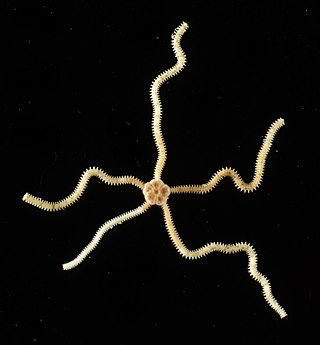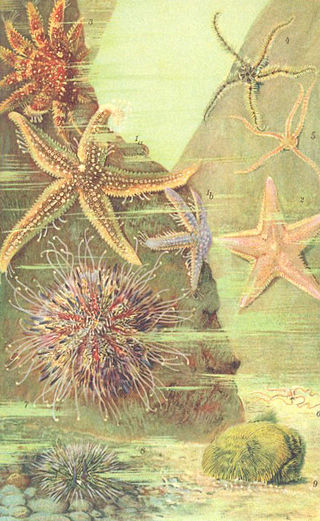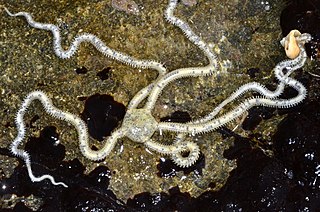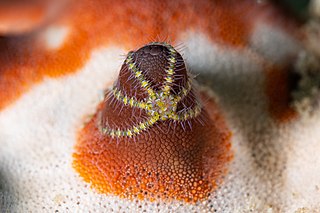
Brittle stars, serpent stars, or ophiuroids are echinoderms in the class Ophiuroidea, closely related to starfish. They crawl across the sea floor using their flexible arms for locomotion. The ophiuroids generally have five long, slender, whip-like arms which may reach up to 60 cm (24 in) in length on the largest specimens.

Amphipholis is a large genus of brittle stars (Ophiuroidea) found in oceans worldwide from tropics to Arctic and Antarctic regions. Some species have been used to study echinoderm development and bioluminescence.
Ophiocanops fugiens is a living species in the brittle star family Ophiocanopidae. Though once considered to be the only one living species in this brittle star family, recent research has brought to light three specimens of Ophiocanops that differ substantially from O. fugiens. It has been regarded as the most primitive brittle star, close to Paleozoic forms, though other authors have disagreed with the view. Classification of O. fugiens is highly argued. Ophiocanops is usually placed in the order Oegophiurida or regarded as a genus incertae sedis or even given its own subclass Oegophiuridea. Some recent data suggest its relationship to the extant family Ophiomyxidae.

Ophiurina are a suborder of brittle stars containing the majority of living brittle star species.

Amphiura callida is a species of brittle star belonging to the family Amphiuridae. It is only known from the continental shelf off the coast of Cabo Frio, southeastern Brazil.

Ophiura ophiura or the serpent star is a species of brittle star in the order Ophiurida. It is typically found on coastal seabeds around northwestern Europe.

Amphiodia pulchella is a species of brittle star belonging to Amphiuridae, a diverse family of the Ophiurida order.

Ophiocoma scolopendrina is a species of brittle star belonging to the family Ophiocomidae. Restricted to life in the intertidal, they live in the Indo-Pacific. They can typically be found within crevices or beneath borders on intertidal reef platforms. Unlike other Ophiocoma brittle stars, they are known for their unique way of surface-film feeding, using their arms to sweep the sea surface and trap food. Regeneration of their arms are a vital component of their physiology, allowing them to efficiently surface-film feed. These stars also have the ability to reproduce throughout the year, and have been known to have symbiotic relationships with other organisms.

Amphiura filiformis is a species of brittle star belonging to the family Amphiuridae. It is found on the seabed in the north east Atlantic Ocean and adjoining seas to a depth of 200 metres (660 ft). It digs itself a shallow burrow in the sand and waves its arms in the water above to suspension feed on plankton.

Amphipholis squamata, common names brooding snake star and dwarf brittle star, is a species complex of brittle stars in the family Amphiuridae.

Amphiura chiajei is a species of brittle star belonging to the family Amphiuridae. It is found in the northeastern Atlantic Ocean and adjoining seas to a depth of 1,000 metres (3,300 ft). It digs itself into the soft sediment of the seabed and raises its arms into the water above to suspension feed on plankton. It was first described by the British naturalist Edward Forbes in 1843, and was named for the Italian zoologist Stefano Delle Chiaje (1794–1860).

Acrocnida is a genus of brittle stars in the family Amphiuridae. The genus contains three members: Acrocnida brachiata, Acrocnida semisquamata, and Acrocnida spatulispina. There has also been observed hybridization between both Acrocnida brachiata and Acrocnida spatulispina. It is a fairly common genus, usually found along the coasts of Northwestern Europe, but with some species like semisquamata appearing around West Africa. Members of this genus primarily prefer intertidal and sub-tidal habitats, and they are they are less likely to be found in intertidal areas by comparison. This genus was not officially classified until 1926, by T. Gislén. One study found that due to the increased calcification that Acrocnida brachiata causes could be a potential source of Carbon Dioxide for not only the warm, shallow environments they live in, but also for the atmosphere.
Acrocnida brachiata, the sand burrowing brittlestar, is a species of brittle star in the family Amphiuridae. It occurs on the seabed in the northeastern Atlantic Ocean and the North Sea, living semi-buried in the sand with only its arm tips projecting.
Amphiodia urtica, commonly known as the burrowing brittle star or the long arm brittle star, is a species of brittle star belonging to the family Amphiuridae. It is found on the Pacific coast of North America at depths down to about 370 m (1,200 ft).
Ailsa McGown Clark (1926–2014) was a British zoologist, who principally studied echinoderms and was a specialist on asteroidea. She worked at the Natural History Museum for most of her career.

Amphiodia occidentalis, the long-armed brittle star, is a species of brittle star belonging to the family Amphiuridae. It is found in the Eastern Pacific coast from Alaska to USA, often on the seafloor within intertidal and subtidal zones. Within these areas, it is often found buried a few centimeters under the sand with 2 or 3 arms extending through the surface.

Ophiothela mirabilis is a species of ophiuroid brittle star within the family Ophiotrichidae. O. mirabilis is an epizoic species which have a non-parasitic relationship with host sponges or gorgonians. Although native to the Pacific Ocean, it has invaded the Caribbean and southwestern Atlantic since late 2000. Many of its characteristics, including reproduction and diet, allow O. mirabilis opportunities to quickly propagate and spread through habitats.

Ophionereis annulata, commonly known as the banded brittle star, is a species of brittle star in the family Ophionereididae.
















